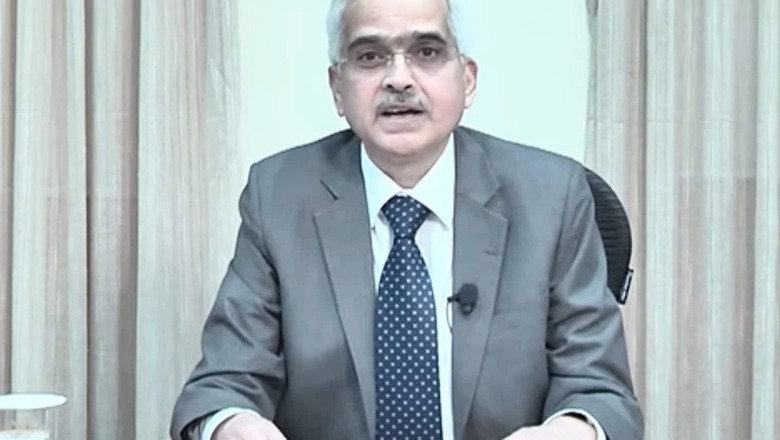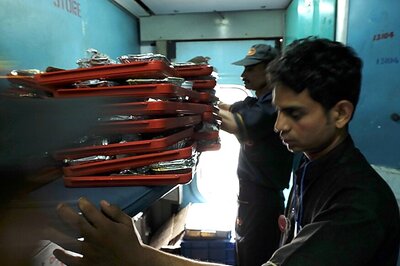
views
The RBI’s Monetary Policy Committee on Friday unanimously decided to raise the repo rate by 50 basis points (bps) to 5.4 per cent with immediate effect while focussing on the withdrawal of accommodation. It has also retained the inflation and GDP forecasts for the current financial year 2022-23 at 6.7 per cent and 7.2 per cent, respectively.
Key Interest Rate Hiked By 50 bps
The key repo rate has increased by 50 basis points, which is the third hike in a row after 40 bps hike in an off-cycle monetary policy review in May and 50 bps in June. The repo rate has now crossed the pre-pandemic level of 5.15 per cent and is the highest since August 2019.
The bank rate, standing deposit facility (SDF) and marginal standing facility (MSF) have also increased by 50 bps each to 5.65 per cent, 5.15 per cent and 5.65 per cent, respectively.
Srikanth Subramanian, CEO-Designate of Kotak Cherry, said, “The RBI rate hike of 50 basis points is in line with our expectations. With Friday’s rate hike we are back to pre-pandemic levels of 5.40 per cent. It was imperative for the RBI to hike rates as it has a clear focus on getting inflation down to its ceiling of 6 per cent.’
Inflation Forecast Retained
The Reserve Bank of India on Friday retained its inflation forecast at 6.7 per cent for the current financial year 2022-23. On the assumption of a normal monsoon in 2022 and average crude oil price (Indian basket) of $105 per barrel, “the inflation projection is retained at 6.7 per cent in 2022-23, with Q2 at 7.1 per cent; Q3 at 6.4 per cent; and Q4 at 5.8 per cent, and risks evenly balanced. CPI inflation for Q1:2023-24 is projected at 5.0 per cent,” according to the monetary policy statement.
While presenting the monetary policy statement, RBI Governor Shaktikanta Das said, “Spillovers from geopolitical shocks are imparting considerable uncertainty to the inflation trajectory. More recently, food and metal prices have come off their peaks. International crude oil prices have eased in recent weeks but remain elevated and volatile on supply concerns even as the global demand outlook is weakening.”
Vivek Iyer, partner and leader (financial services risk) at Grant Thornton Bharat, said, “With inflation expected to be above 6 per cent for Q2 and Q3, we expect regular RBI interventions in the next two quarters – Q2 and Q3 of FY 23 – to ensure rupee stability. With inflation expected to go below 6 per cent in Q4 of FY23 and then to go down further in Q1 of FY24, we expect the RBI not to use rate hikes as a tool anymore in those quarters and move to liquidity management measures to ensure that the growth is not stiffled.”
GDP Forecast Retained
The RBI has also retained its GDP outlook for FY23 at 7.2 per cent. According to the RBI, “The real GDP growth projection for 2022-23 is retained at 7.2 per cent, with Q1 at 16.2 per cent; Q2 at 6.2 per cent; Q3 at 4.1 per cent; and Q4 at 4.0 per cent, and risks broadly balanced. Real GDP growth for Q1:2023-24 is projected at 6.7 per cent.”
Das said, “Rural consumption is expected to benefit from the brightening agricultural prospects. The demand for contact-intensive services and the improvement in business and consumer sentiment should bolster discretionary spending and urban consumption. Investment activity is expected to get support from the government’s capex push, improving bank credit and rising capacity utilisation.”
He, however, said elevated risks emanating from protracted geopolitical tensions, the upsurge in global financial market volatility and tightening global financial conditions continue to weigh heavily on the outlook.
Announcements For Standalone Primary Dealers
The RBI decided to enable standalone primary dealers (SPDs) to offer all foreign exchange market-making facilities as currently permitted to Category-I Authorised Dealers, subject to prudential guidelines. It also allowed them to undertake transactions in the offshore rupee overnight indexed swap (OIS) market with non-residents and other market makers.
Code of Conduct in Outsourcing of Financial Services Soon
To harmonise and consolidate the extant guidelines, a draft Master Direction on Managing Risks and Code of Conduct in Outsourcing of Financial Services will be issued shortly for comments from stakeholders, the RBI governor said.
Bharat Bill Payment System Allowed To Accept Cross-Border Payments
The Bharat Bill Payment System (BBPS) is an interoperable platform for standardised bill payments. The RBI has now allowed it to accept cross-border inward bill payments. This will enable non-resident Indians (NRIs) to undertake bill payments for utility, education and other such payments on behalf of their families in India. “This will greatly benefit the senior citizens in particular,” Das said.
Credit Information Companies under RBI’s Ombudsman Scheme
Das said the Reserve Bank-Integrated Ombudsman Scheme (RB-IOS) has improved the customer grievance redress mechanism. The turnaround time of grievance redress under RB-IOS has declined considerably. “In order to make the RB-IOS more broad-based, it has been decided to include credit information companies (CICs) under the RB-IOS framework. This will provide a cost-free alternative redress mechanism for grievances against CICs… It has been decided to mandate the CICs to have their own internal ombudsman framework.”
Committee on MIBOR Benchmark
The RBI on Friday also proposed to set up a committee to study the need for transition to an alternative benchmark for MIBOR. The panel has been set up in view of the recent international efforts to develop alternative benchmark rates. “The Reserve Bank has been taking measures, from time to time, to develop the interest rate derivatives (IRD) market in India. Such measures have led to diversification of the participant base and increased use of IRD instruments, such as the Mumbai Interbank Outright Rate (MIBOR) overnight indexed swap (OIS) contracts,” Das said.
Read the Latest News and Breaking News here




















Comments
0 comment